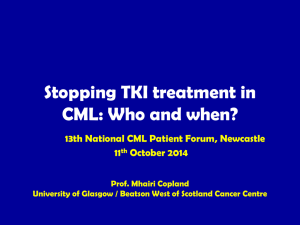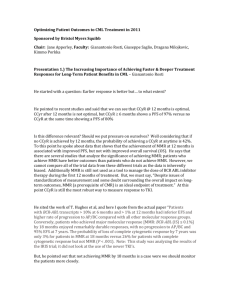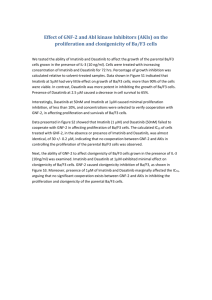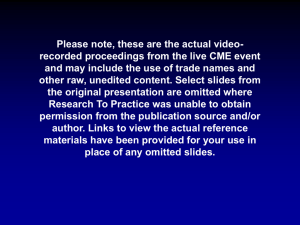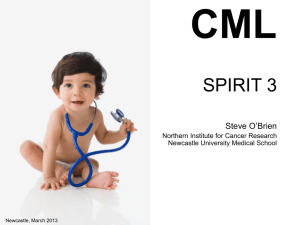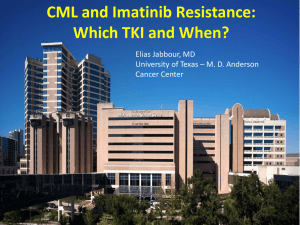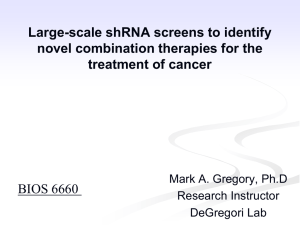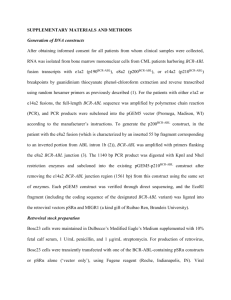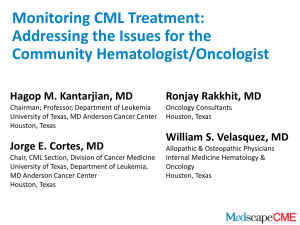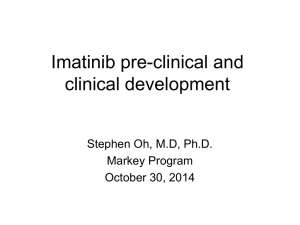Presentation - Chronice Myeloid Leukemia
advertisement
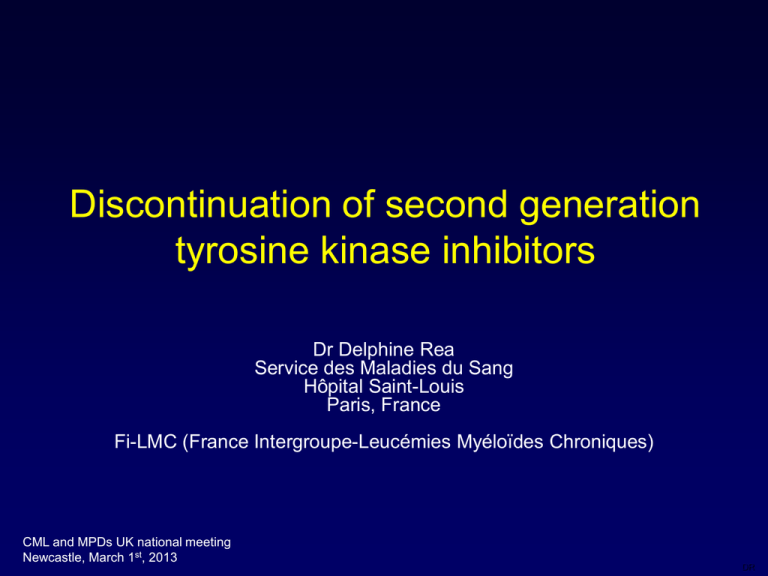
Discontinuation of second generation tyrosine kinase inhibitors Dr Delphine Rea Service des Maladies du Sang Hôpital Saint-Louis Paris, France Fi-LMC (France Intergroupe-Leucémies Myéloïdes Chroniques) CML and MPDs UK national meeting Newcastle, March 1st, 2013 DR Current goals of TKI therapy « Induction » phase Leukemic burden CP-CML at Diagnosis PFS « Lifelong maintenance » EFS Near-normal life expectancy CHR, Minor CyR PCyR CCyR MMR M3 M6 M12 M18 Stable or improving MMR > M18 Treatment change upon lack or loss of an optimal response, progression or unacceptable side effects Baccarani et al. JCO 2009; 27: 6041-6051 Björkholm et al. JCO 2011: 2514-2420 Gambacorti-Passerini et al. JNCI 2011; 103: 553-561 Time on TKI therapy DR Evidence that TKIs may not be curative • Primitive CD34+CD38- BCR-ABL+ cells are insensitive to imatinib-, dasatinib-, nilotinib- and bosutinib-induced cell death in vitro1-4 • CD34+CD38- BCR-ABL+ cells escape from TKI-induced cell death is independent from BCR-ABL in vitro5 • CD34+CD38- BCR-ABL+ residual cells in optimal responders to imatinib survive independently from BCRABL and possess in vivo repopulating capacities in mice6 1Graham et al. Blood 2002; 99: 319-325 et al. Blood 2006; 107: 4532-4539 3Jorgensen et al. Blood 2007; 109: 4016-4019 4Konig et al. Blood 2008; 111: 2329-2338 5Corbin et al. JCI 2011; 121: 396-406 6Hamilton et al. Blood 2012; 119: 1501-1510 2Copland DR Median BCR-ABL (IS) transcript levels over 84 months in the IRIS trial 0.003% 0.004% Hughes et al. Blood 2010; 116: 3758-3765 DR STIM: Stopping imatinib is feasible Survival without molecular relapse CP-CML Imatinib ≥ 3 years Undetectable BCR-ABL ≥ 2 years 1.0 0.9 0.8 0.7 0.6 0.5 0.4 0.3 0.2 0.1 0.0 Survival without molecular relapse: 39% (95% CI: 29-48) at 24 and 36 months Molecular relapses: n=61 Median follow-up: 34 months (9-50) 0 3 6 9 12 15 18 21 24 27 30 33 36 39 42 45 48 51 54 57 60 Months since discontinuation of imatinib Undetectable BCR-ABL: at least 50 000 copies of the ABL control gene Molecular relapse: defined by 2 positive RQ-PCR results over 1 month showing a significant rise in BCR-ABL transcripts; triggers imatinib resumption. Mahon et al. Blood (ASH) 2011; 118: Abstract 603 DR Factors potentially associated with outcome Study Factors French prospective STIM study1 Sokal risk group Imatinib treatment duration Australian prospective CML8 study2 Sokal risk group IFN treatment duration prior to imatinib therapy Japanese survey3 Imatinib treatment duration Duration of undetectable BCR-ABL transcripts Imatinib dose intensity Prior exposure to IFN Korean retrospective study4 Sokal risk group Time to undetectable BCR-ABL transcripts Imatinib treatment duration 1Mahon 3Takahashi 2Ross 4Yhim et al. Blood (ASH) 2011; 118: Abstract 603 et al. Haematologica 2012; abstract 0189. et al. Haematologica 2012; 97: 903-906 et al. Leukemia Research 2012; 36: 689-693 DR Rationale for 2G-TKI discontinuation • Dasatinib and nilotinib display increased potency in vitro against BCR-ABL compared with imatinib1 • Dasatinib and nilotinib are efficient salvage therapies in patients with intolerance or resistance to imatinib2,3 • Frontline dasatinib and nilotinib induce higher rates of deep molecular responses than imatinib4,5 • Case reports on dasatinib cessation in 4 patients with imatinib-resistant CML with very low or undetectable BCRABL transcripts6,7 4Saglio 1O’Hare et al. Cancer Res 2005; 65: 4500-4505 2Shah et al. J Clin Oncol 2008; 26; 3204-3212 3Kantarjian et al. Blood 2007; 110: 3540-3546 et al. N Engl J Med 2010; 362: 2251-2259 et al. N Engl J Med 2010; 362: 2260-2270 6Rea et al. Leukemia 2009; 23: 1158-1159 7Ross et al. Haematologica 2011; 96: 1720-1722 5Kantarjian DR STOP 2G-TKI: study design CP-CML TKI therapy ≥ 3 years 2G-TKI frontline or after imatinib intolerance or resistance Undetectable BCR-ABL* ≥ 24 months • • • STOP 2G-TKI D1 M12 M24 Year 1 Year 2 RQ-PCR monthly RQ-PCR Every 2-3 months M36 M48 M60 Year 3-5 RQ-PCR Every 3-6 months Primary endpoint: survival without loss of MMR Molecular relapse: loss of MMR Loss of MMR triggered treatment resumption *Molecular monitoring performed in local laboratories filling international standardization requirements. *20 000 copies of ABL at least. DR Baseline characteristics Data, as of November 30, 2012 Patients with a min. follow-up of 6 months (median 17: 7-38), n=39 Median age 58 years (34-81) Gender Male n= 15 (38.5%), Female n=24 (61.5%) CML phase at diagnosis Sokal risk group Low / Intermediate / High / Unknown CP 100% 21 (54%) / 9 (23%) / 6 (15%) / 3 (8%) Prior IFN (+/- AraC) 12 (33%) Prior TKI Dasatinib or nilotinib only Imatinib + dasatinib or nilotinib Imatinib + dasatinib and nilotinib 2 (5%) 31 (79%) 6 (16%) Reason for 2G-TKI Upfront Intolerance to imatinib Suboptimal response/resistance to imatinib* 2 (5%) 27 (69%) 10 (26%) TKI discontinuation Dasatinib / nilotinib 20 (51%) / 19 (49%) Median time since diagnosis Median time since first TKI Median time since 2G-TKI Median duration of undetectable BCR-ABL transcripts 84 months (31-218) 78 months (30-133) 37 months (19-72) 27 months (19-58) *ELN 2006 definition Rea et al. Blood (ASH) 2012; 120: Abstract 916 DR STOP 2G-TKI Survival without MMR loss • Median follow-up was 17 months (7-38) Survival without MMR loss % – 16/39 patients lost MMR – Median time to MMR loss was 3 months (1-25) 100 Month 12: 61.1% (95% CI: 45.6-76.6) 80 60 40 20 0 0 Rea et al. Blood (ASH) 2012; 120: Abstract 916 6 12 18 24 30 36 42 Months since 2G-TKI discontinuation KM analysis DR STOP 2G-TKI Outcome after MMR loss • Median BCR-ABL transcript level at MMR loss: – 0.35% IS (0.12-1.95) • TKI therapy resumption in 15/16 patients – Median time between MMR loss and therapy resumption: 1 month (0-4) – Same 2G-TKI used prior to discontinuation in all patients but 1 • No loss of CHR or progression to AP/BP • With a median follow-up of 7 (1-35) months after therapy resumption: – MMR regained in14 patients, median time to MMR 2 (1-6) months – Undetectable BCR-ABL transcripts in 14 patients after a median time of 4 months (3-10) Rea et al. Blood (ASH) 2012; 120: Abstract 916 DR STOP 2G-TKI Responsiveness to 2G-TKI upon therapy resumption: patient case STOP DASATINIB BCR-ABL/ABL % IS 10 DASATINIB RESUMPTION 1 MMR 0.1 0.01 MR4.5 0.001 0.0001 0 6 Detectable BCR-ABL Undetectable BCR-ABL with at least 32000 copies of ABL 12 18 24 30 36 42 48 54 60 66 Months since dasatinib-induced undetectable BCR-ABL transcripts Dr D Rea, Hôpital Saint-Louis, Paris DR STOP 2G-TKI Factors associated with outcome Factors Estimated survival without MMR loss at 12 months (%, 95% CI) p value Age: ≤ 58 years vs > 58 68.7 % (44.8-89.7) vs 52.6 % (30.2-75) 0.219 Gender: Female vs male 61.3 % (41.3-81.3) vs 66.7 % (42.8-90.5) 0.901 Sokal risk group: Low vs others 66.7 % (46.5-86.8) vs 52.1 % (29.4-74.8) 0.31 Prior IFN exposure: no vs yes 56.8 % (37.4-76.2) vs 69.2 % (44.1-94.3) 0.581 Reason for 2G-TKI: Frontline/imatinib intolerance Suboptimal response/resistance to imatinib 68.2 % (51-85.5) 40 % (9.6-70.4) 0.0188 Type of 2G-TKI: Dasatinib vs nilotinib 60 % (38.5-81.5) vs 62.7 % (40.8-84.7) 0.599 Time since diagnosis: ≤ 84 months vs > 84 months 63.6 % (41.8-85.4) vs 57.9 % (35.7-80.1) 0.599 Time since first TKI: ≤ 78 months vs > 78 months 63.6 % (41.8-85.4) vs 57.9 % (35.7-80.1) 0.599 2G-TKI duration: ≤ 37 months vs > 37 months 62.2 % (42.7-81.7) vs 66.7 % (42.8-90.5) 0.949 UMRD duration: ≤ 27 months vs > 27 months 70 % (49.9-90.1) vs 52.1 % (-74.8) 0.310 KM analysis, two-tailed logrank test Rea et al. Blood (ASH) 2012; 120: Abstract 916 DR STOP 2G-TKI BCR-ABL transcripts in patients remaining in MMR Patients in MMR without therapy (median follow-up 17 months: 7-37) n=23 Always undetectable 7/23 (30.4%) Occasionally detectable on 1 test 8/23 (34.8%) Occasionally detectable on ≥ 2 consecutive tests 8/23 (34.8%) DR Different outcomes of persistent LSC CML disease relapse Self renewal STOP TKI TKI + BCR-ABL+ LSC Survival Ph+ LSCdriven hematopoiesis Pro Deep and sustained Molecular response STOP TKI Inhibited Ph+ LSCdriven hematopoiesis Why ? CML-related factors? Mat Mat Mat Mat Pre Pre Pro Pre Therapy-related factors? No CML disease relapse Host-related factors? DR DR Conclusions • Discontinuation of 2G-TKI in patients with deep and sustained molecular responses is possible without jeopardizing short-term outcome, under strict monitoring conditions. • TKI discontinuation may not be a realistic goal for all patients but the increasing use of 2G-TKI may broaden access to treatment discontinuation attempts. • Patients who successfully stop TKI may not be definitively cured, likely because of LSC persistence. • Unknown long-term risk of relapse, acquired resistance and progression to AP/BP after TKI discontinuation. • Targeting residual LSC with specific compounds may offer a chance for a definitive cure. DR
